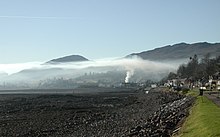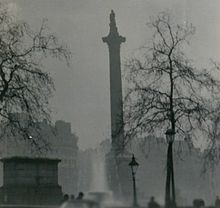Smokeless fuel
This article needs additional citations for verification. (April 2021) |

Smokeless fuel is a type of solid fuel which either does not emit visible smoke, or emits minimal amounts, during combustion. These types of fuel are becoming increasingly popular in areas which ban the use of coal and other fuels such as unseasoned or wet wood which produce much smoke. Open fires are still popular with many domestic consumers, especially for those living in older houses where open fireplaces have not been removed or replaced by stoves for example. All houses older than about 1970[where?] are fitted with open fireplaces when coal was in widespread use for domestic heating. However, modern houses are rarely equipped with fireplaces and central heating with natural gas or electricity is the usual choice.[citation needed] As a result of many places banning smoke and pollution, some studies have shown that overall air quality has improved along with fewer annual deaths related to smoke.[1] Many[who?] consider smokeless fuel to be the near future replacement of all other solid fuels which cause toxic smoke emissions.[citation needed] The term in general is used to refer to solid fuels, such as: anthracite, coke, charcoal and hexamine fuel tablets. Smoke free carbonaceous fuels are usually supplied in the form of standard pillow-shaped briquettes made from powdered coal or charcoal. Fuel tablets are used by campers and walkers for temporary cooking using a small folding metal stove.
History[]

Coal was widely used for domestic cooking and heating during the Victorian period and up to the early 1950s in most towns in Britain. However, poor coal fuels and badly designed fireplaces created a good deal of local pollution from smoke and tars produced from partial combustion of the coal and disappeared up the chimney. As a result, the smoke and noxious gases were often trapped locally when a weather inversion occurred. Such trapped gases and smoke caused fogs and worse, smogs which discoloured clothing and was a serious health hazard. Such pea soupers were generally more prevalent in the larger towns such as Manchester, Birmingham and London. There were also toxic gases such as sulphur dioxide and nitrogen oxides present in the same noxious mixture, both of which irritated the lungs of those exposed to the smog. The former gas produced by sulphur impurities in the coal, was especially iniquitous since it oxidises further in the air to produce sulphuric acid, a highly corrosive and strong acid.
London[]

In 1952 The Great Smog of London killed directly a great number of people varying between 4 and 12 thousand people by exacerbating existing lung diseases such as bronchitis and breathing disorders like asthma. It also killed indirectly by causing many rail, road, and pedestrian accidents created by the impenetrable gloom of the smog.[2] Clothes were stained by the soot and generally discoloured by the sulphurous gases. Because of this tragedy the Clean Air Act 1956 was passed to attempt to solve this problem.[3] One of the results of this act was the development of smokeless fuels, which were designed specifically to aid the environment by reducing the amount of smoke produced, as well as removing some impurities such as sulphur in the coal. Such manufactured fuels also burnt at a higher temperature and so made for a better and more efficient fuel for open fires as well as stoves.
Benefits[]


Smokeless fuels can have several benefits over other solid fuels such as bituminous coal or anthracite. They are usually more expensive than coal, and often consist of briquettes of standard size (ca 3 inches long and wide by 1 inch thick) aiding transport, handling and fire-making. Coal however, may often be supplied in a large variety of sizes from fines to large lumps. Slack such as stone and shale or even coal dust can choke a fire and usually produces a great deal of smoke. The variable size of the coal results in inconsistent burning, the smaller particles burning faster than the larger. The advantages of a standard sized briquette of smokeless coal include regular burning for longer (less refueling needed) and burning at a higher temperature, so making an open fire more efficient. They can also improve air quality by reducing smoke formation[4] They are generally of more consistent quality since are mass made by compression moulding of powdered coal and a binder such as starch. They can be used in many different appliances such as enclosed stoves as well as open fires.[5]
Smokeless coal is more efficient than a conventional open coal fire indoors because the high working temperature is radiated into the room as infra-red radiation, as can be judged by the bright red coloration of a mature fire. The hot gases produced are lost up the chimney, thereby reducing efficiency just as in an open coal fire. The gases mainly consist of carbon dioxide, carbon monoxide, and some water vapor. With little or no smoke or similar volatile compounds, chimneys remain cleaner longer and require brushing less frequently. The main combustion reaction is:
C(s) + O2(g) → CO2(g)
In a restricted supply of air or oxygen, then toxic carbon monoxide can be formed:
2C(s) + O2(g) → 2CO(g)
Charcoal, either in unprocessed sticks or as shaped briquettes, is widely used for outdoor barbecue grills owing to its relatively low production of smoke and the intense heat generated which cooks food relatively quickly. What little smoke is produced by the charcoal may impart a smoky flavor to grilled food. Charcoal, tea, and raw wood are also commonly used in the manufacture of various smoked products such as smoked salmon. Charcoal is widely used in African countries for domestic cooking purposes.
Hexamine fuel tablets are entirely for the convenience of hikers and campers, and the fuel consist of white tablets made from trioxane, so it is a completely synthetic fuel and made from formaldehyde.
Calorific value[]
Smokeless fuels generally have a high calorific value, with that of anthracite being greater than dry wood for example, and many smokeless briquettes are made from this type of coal. Thus anthracite has a calorific value of 32.50 MJ/kg compared with that of dry wood of about 21 MJ/kg. Lignite or brown coal is even worse with a heat of combustion of only 15.00 MJ/kg owing to the presence of non-combustible impurities. Bituminous coal has a value lower than anthracite, but neither lignite nor bituminous coal are smokeless owing to volatile content.
Downsides[]
Smokeless fuels also have some downsides, typically they can be harder to ignite owing to the lack of volatiles present in anthracite for example. There are fewer flames, due to reduced volatiles but a generally higher ash content. Fines and dust can be produced by abrasion from mechanical movement but the amount is minimal compared with that produced by bituminous coal. It is sometimes supplied wet, even in sealed plastic bags, but is easily dried since the moisture is superficial. There is an increased cost to the user or consumer owing to the costs of mass manufacture although the loss of volatile chemicals such as coal tar can offset those costs to the manufacturer. Those extra costs make the fuel more expensive than coal, but the effect is small at about a 30% premium over coal at 2020 prices.
Since solid fuels are bulky and heavy, they need manual transport to the fireplace and storage in a convenient spot near to the house such as a coal bunker.
See also[]
- Briquette
- Clean Air Act Amendments of 1990
- Clean Air Act 1956
- Coke (fuel), a smokeless fuel made by carbonizing coal
- Energy density
References[]
- ^ "What is Smokeless Fuel? - Definition from Safeopedia". safeopedia.com. Retrieved 2019-02-14.
- ^ Editors, History com. "Smog kills thousands in England". HISTORY. Retrieved 2019-02-14.CS1 maint: extra text: authors list (link)
- ^ HouseFuel (2019-01-09). "Why Use Smokeless Fuel". HouseFuel. Retrieved 2019-02-14.
- ^ "Smokeless fuels benefits". www.coals2u.co.uk. Retrieved 2019-02-14.
- ^ "What is Smokeless Fuel? | Coal Products". www.coalproducts.co.uk. Retrieved 2019-02-14.
- Fuels
- Technology stubs